Family Violence Is Most Difficult to Detect Due to
Violations of children's rights remain tragically mutual beyond the world. But variations across countries are large and historically we have seen several forms of violence declining – both suggesting that it is possible to make progress and protect children.
All our charts on Violence confronting children and children'southward rights
Related research entries
Child labor – In this entry we present statistics and research on child labor, including historical estimates.
What counts every bit trigger-happy discipline?
The two main forms of violent discipline are corporal punishment and psychological violence.
According to UNICEF, physical discipline, also known as 'corporal punishment' refers to any punishment in which physical strength is used to cause any degree of pain or discomfort. Information technology includes, for example, pinching, spanking, hitting children with a hand, or forcing them to ingest something.
Violent psychological subject field involves "the employ of exact aggression, threats, intimidation, denigration, ridicule, guilt, humiliation, withdrawal of honey or emotional manipulation to control children".
Tearing subject field is a violation of a child'due south correct to protection from all forms of violence while in the care of their parents or other caregivers, as set forth in the United Nation's Convention on the Rights of the Child.
How common is trigger-happy field of study at dwelling house?
Children are bailiwick to corporal punishment and psychological violence around the world
The two master forms of fierce bailiwick are corporal penalization and psychological violence. Around the world, children are subject to one or both of these. The available data suggests that in some countries, violent discipline is the norm.
The bar nautical chart here shows the per centum of children aged two-fourteen years old who, according to self-reports past caregivers or other household members, experienced any violent field of study at home in the past month, whether in the form of psychological assailment and/or physical punishment.
Tearing discipline is slightly less common in richer countries
As we see in the scatter nautical chart, violent discipline is slightly less common in richer countries; but the available data shows that in almost all countries information technology is only a minority of children who do not experience whatsoever fierce discipline.
Children frequently feel both corporal penalisation and psychological violence
The evidence shows that violent disciplinary methods often go together, which ways in the majority of countries virtually children experience both corporal punishment and psychological violence. In the stacked bar chart we see the pct of children aged 2-14 years old who experience only psychological violence; only physical violence; and those who feel both.
Percentage of children (2-14) who experience concrete penalisation and psychological aggression – UNICEF (2014)1
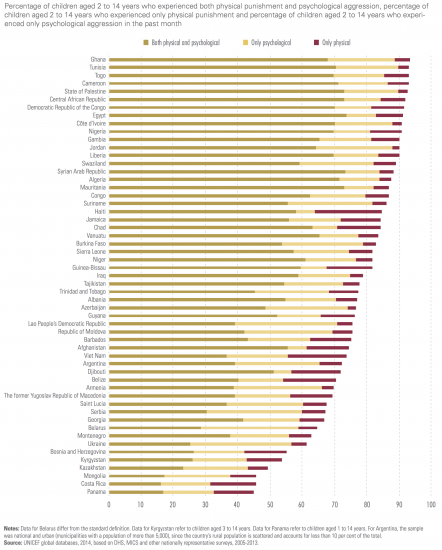
Parents' perceptions virtually violent subject field
How are parents' perceptions most violent subject changing over fourth dimension?
Long-run information on trigger-happy bailiwick confronting children is not bachelor for most countries. In the United States, however, the General Social Survey (GSS) has been gathering data on parents' perceptions regarding tearing discipline for over three decades. The GSS data, plotted in the nautical chart here, shows that today about ii-thirds of American parents agree with the statement "Sometimes a kid but needs a good, hard spanking." Equally the chart shows, loftier as this number is, there has been an important reduction over the catamenia. And this is true both for parents who 'strongly agree' and 'hold' with spanking.
Violent subject area against boys and girls
Is fierce discipline used similarly ofttimes against boys and girls?
Every bit this scatter plot shows, vehement discipline is slightly more unremarkably used against boys than girls. But the differences are not large and the cantankerous-country differences in full violent punishment are much larger than the within-country gender differences. In countries where violent bailiwick is mutual, it typically affects most boys and girls.
How mutual is violent discipline in schools?
According to figures from the Global Initiative to Cease All Corporal Penalty of Children, in 69 countries corporal punishment has not been fully prohibited in schools.
Data on violent discipline in schools is sparse. But the available estimates suggest this is an important trouble in many countries. In Bharat, for case, almost 4 out of v children historic period eight study physical penalty past teachers.
(NB. This other interactive nautical chart shows estimates of self-reported physical penalization by teachers amidst children historic period 15)
Child Labor
Bullying and violence at schoolhouse
- Bullying
- Fights
- Violent crime in US schools
Bullying
In its broadest sense, bullying refers to the use of aggression to affirm power over someone. More than specifically, it has been defined past researchers as "actions, either physical or exact, that have a hostile intent, are repeated over time, cause distress for the victim and involve a power imbalance betwixt the perpetrator and victim."2
Bullying is an of import form of violence at schools in many countries, and is prevalent beyond all regions. The map here shows the percentage of adolescents aged between 13-15 years old who reported beingness bullied at least once in contempo months. Some countries – being highest, on average, beyond African countries – reported a prevalence greater than 50 percent; countries across the Americas and Europe tended to report slightly lower rates between 20-forty percent.
Fights
Concrete fighting in schools is common
Physical fighting at school tends to be more common among boys
In most countries the prevalence of physical fighting tends to be college among males than females, though information technology remains common in most countries across both genders.
Percentage of adolescents aged 13 to 15 years who reported having been involved in physical fights over the past 12 months, 2009-2012 – UNESCO (2016)3
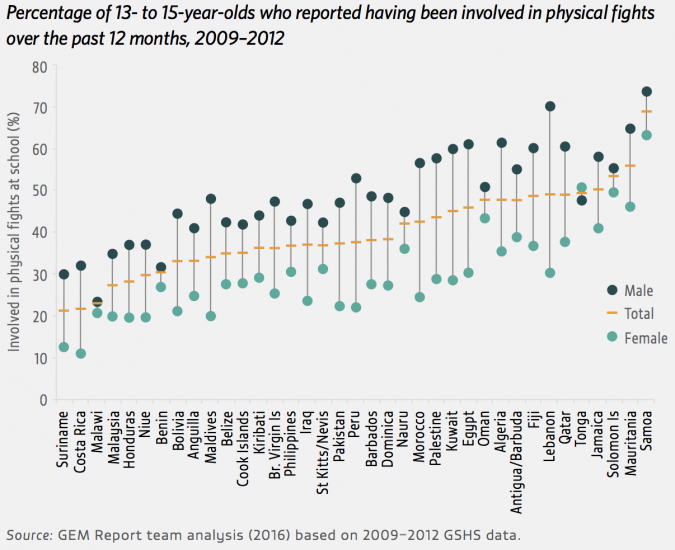
Trigger-happy offense in United states schools
In the US, violent crimes in schools are common merely less then than in the by
This chart plots the prevalence of violent crimes in schools, among students aged 12 and older in the US. It covers both completed and attempted crimes, including rape, sexual assault and personal robbery.
As we tin encounter, there has been a large reduction in vehement crimes in schools in the US over the last couple of decades.
Sexual violence against children
- Self-reported sexual corruption
What are the main forms of sexual violence against children?
Sexual violence against children encompasses situations "in which a child is forced to perform a sexual human activity by a caregiver or neighbour, pressed to have unwanted sexual intercourse by a dating partner, exposed to sexual comments or advances by a peer or an adult, impelled to engage in sexual practice in exchange for cash, gifts or favours, coerced to betrayal her or his sexual body parts, including in person or online, subjected to viewing sexual activities or sexual body parts without his or her consent, or raped past a grouping of persons as part of a ritual, a form of penalization or the cruelty of war."4
The post-obit are some of the nigh common forms of sexual abuse:
- Forced sex: Sexual intercourse or any other sexual acts that were forced, physically or in whatever other mode.
- Sexual abuse: Sexual touching, unwanted attempted sexual practice, pressured sex and physically forced sex.
- Sexual touching: Unwanted touching of the victim in a sexual way, such every bit kissing, grabbing, pinching or fondling.
- Pressured sex: Situations in which the victim was pressured in some way (e.1000., threatening, harassing, luring or tricking) to take sexual intercourse confronting her or his will and sexual intercourse was completed.
- Physically forced sex activity: Situations in which the victim was physically forced to have sexual intercourse against his or her volition.
- Unwanted attempted sexual activity: Situations in which a perpetrator tried to make the victim accept sexual intercourse when she or he did not desire to only was unsuccessful in completing sexual intercourse.
Self-reported sexual abuse
Data on sexual abuse of children is extremely difficult to capture since many victims are non able or willing to study their situation. However, available estimates of self-reported sexual victimization show that this is an extremely common tragedy.
Different forms of sexual abuse
This visualization provides a comparison of different forms of sexual corruption against women (do conduct in mind that the figures are not straight comparable to those in the chart above, since the historic period brackets do not coincide).
Percentage of women aged 18 to 24 years who study having experienced any sexual abuse earlier the age of 18, past blazon of abuse – UNESCO (2017)5
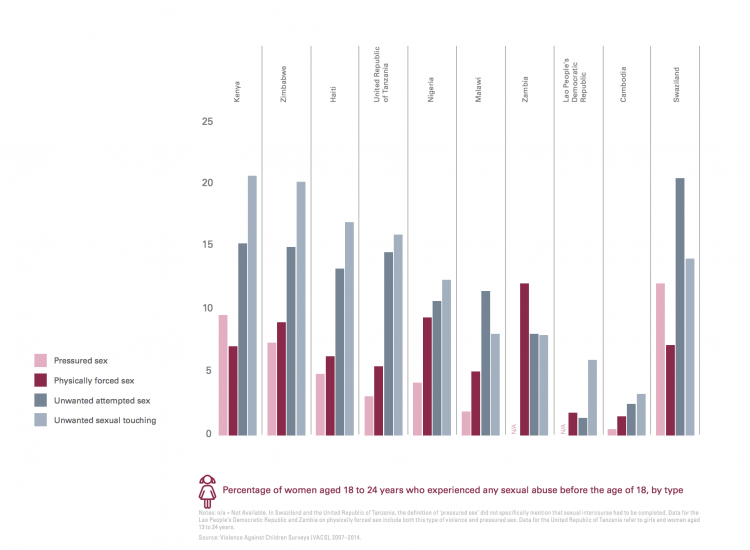
Sexual abuse of boys
Contrary to common perception, boys also report experiences of sexual abuse, but to a lesser extent than girls. Nonetheless, it is important to bear in heed that it is possible that boys are fifty-fifty less probable than girls to report incidents of sexual corruption.6
Child matrimony
Children who are married or in an informal union with an older adult, tend to be particularly vulnerable to violence, especially sexual and domestic violence.7
Marriage and informal unions are very mutual in many parts of the world
Kid marriage is legal in several countries
In many countries there are provisions that foreclose the marriage of girls, boys, or both, before they reach the legal age of marriage. Even so the legal context that allows child marriage is typically more than complex than a elementary 'yes/no' question. In several countries the minimum age of union is different for men and women, and it is besides often the case that the law allows exceptions regarding consent, or even exceptions for some groups of women.
The post-obit ii maps show these differences across countries.
In that location have been reductions in kid marriage rates over the last few years
Importantly, notwithstanding, according to the World Bank'southward 2017 Economic Impacts of Child Marriage study, in many countries where child marriage is common, at that place take been reductions in child union rates over the last few years.
Share of women in each age group who were married before age 18 – Globe Bank Featured Story (2017)8
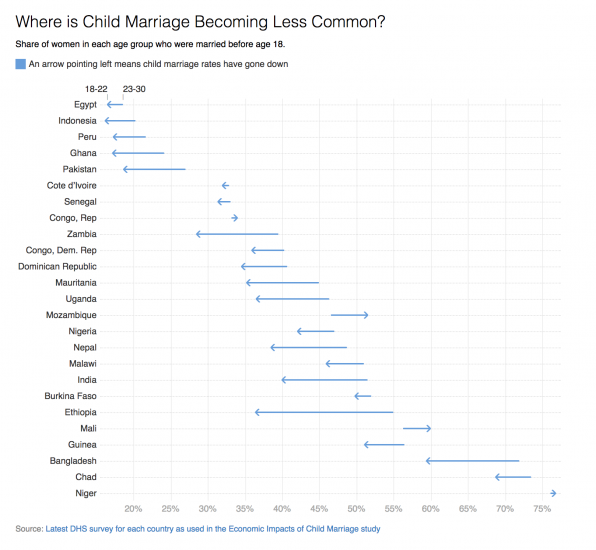
Female genital mutilation
As noted past the WHO, female genital mutilation has no health benefits for girls and women. But it ofttimes does crusade severe bleeding and problems urinating, and subsequently cysts, infections, as well equally complications in childbirth and increased risk of newborn deaths (more details from the WHO Factsheet).
Female genital mutilation remains a mutual form of violence against women in many parts of the world. And, as it is nearly always carried out on minors, it constitutes a violation of the rights of children.
The exercise is most mutual in the western, eastern, and n-eastern regions of Africa, in some countries the Heart E and Asia, also as amid migrants from these areas.
This chart shows the percent of women anile fifteen-49 years old who have gone through partial or total removal of the female external genitalia or other injury to the female genital organs for cultural or other non-therapeutic reasons. Shown are all countries with bachelor data.
Child homicides
Corporal punishment and behaviour
Is corporal punishment an effective method of discipline?
In a recent study, Gershoff, Sattler and Ansari (2017)nine analysed data from more 12,000 families in the US, as part of the nationally representative Early on Babyhood Longitudinal Study, in order to explore whether fierce discipline was associated with reductions in misbehavior even later controlling for children's initial behavior problems and the characteristics of their parents.
The researchers made comparisons between children who had and had non been spanked at 5 years old only were equivalent on 38 other factors (the 'control variables'). These other factors covered baseline behavior issues (as rated by the teacher), mental health, stress levels and parenting style (as defined past parents' answers to interview questions).
The study reports that children who experienced violent subject at historic period 5 were more than probable to have behavior bug later on, co-ordinate to teachers' ratings. The report too found that the link between corporal punishment and misbehavior was even stronger if parents said that they had spanked their kid the week before the survey, which may exist considered a sign of relatively frequent spanking.
To the extent that these results are difficult to explicate by alternative hypothesis, this is arguably the best prove we have (outside of an experiment, which is of course not feasible in this context) about the likely negative effects of corporal punishment on children'south behavior.
You lot can read a summary of this report in this overview article in The Wall Street Journal.
The link between child maltreatment and children's educational outcomes
Child maltreatment is common and takes many forms. From physical or emotional abuse, to child labor and other practices that violate their most bones rights.
Violence confronting children, at abode, schools, or in the broader guild, affects educational outcomes. It affects whether children are able to nourish and remain in school, as well every bit whether they brand progress in terms of learning outcomes. And at the aforementioned time, educational outcomes affect violence – educational activity has been identified as a tool to reduce violence against children.
In this section of the entry we focus on the importance of kid maltreatment specifically in the context of children's education and give an overview of the empirical evidence.
Children who work tend to nourish school less ofttimes
Child labor constitutes in most situations a violation of children's rights, as it is frequently linked to several forms of corruption and damage. Specifically in the context of instruction, kid labor is often linked to poor educational outcomes. The chart here, from Schultz and Strauss (2008),x shows evidence for this. It plots school attendance rates for children aged 10–14 years olds, confronting full hours worked in the last calendar week (past type of work) with 95 percent conviction intervals (labeled CI and plotted in lighter shades).
Children who piece of work more than hours tend to nourish school less ofttimes. And the steepest segments of the pictured curves are in the range twenty-45 hours, which suggests — as one would naturally look — that it is virtually difficult for a child to attend school when budgeted total-time work.
This prove as well shows that in that location is no significant difference betwixt children engaged in domestic or marketed work.
School Attendance vs. Hours Worked – Schultz and Strauss (2008) 11
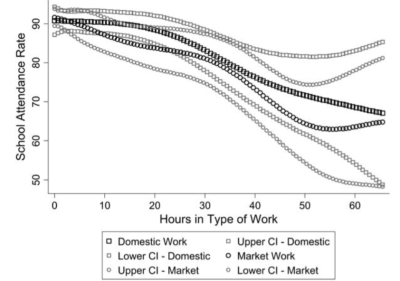
In countries where children tend to work longer hours, it is more mutual that working children remain out of schoolhouse
The chart to a higher place shows the relationship between school attendance and hours worked using micro data, which ways that the authors investigate the human relationship across private households. A similar pattern can too be seen in the data if nosotros wait at the respective state-level macro variables: In countries where children tend to work longer hours, information technology is more mutual that working children remain out of school. The interactive nautical chart beneath shows this past plotting country-level average hours worked by children against share of working children who are out of school.
There is prove of a causal link between child labor and didactics outcomes
These correlations on the micro and macro level are of course not enough to establish a causal relationship. There are many potential economic and cultural factors that simultaneously influence both schooling and piece of work decisions; and in whatsoever case, the direction of the relationships is not obvious—do children work because they are not attending school, or do they fail to nourish school because they are working?
A number of academic studies have tried to investigate whether at that place is indeed a causal human relationship by attempting to find a factor (an 'instrumental variable') that only affects whether a child works without affecting how the family values other uses of the child'south fourth dimension. These studies – like Rosati & Rossi (2003) or Gunnarsson, Orazem & Sanchez (2006) – suggest that there is indeed a causal relationship: piece of work often does determine whether a child remains in, or drops out of, school.12 thirteen
Students who are victims of corruption at schoolhouse tend to have worse educational outcomes
Children who are victims of physical or psychological abuse tend to have worse educational outcomes; and while evidence supporting a causal link is scarce, it is important to pay attending to these correlations.
A contempo study used detailed household surveys from South Africa and Malawi to document the prevalence of violent subject field and subsequent changes in school progress amidst the affected children. The study found that children who were exposed to psychological and physical violence for discipline were more likely to have dropped out of school upon follow-upwardly (Sherr et al. 2015).14
Other studies take found that violence against children also correlates with poor educational outcomes in the long run. In rich countries, for example, studies accept constitute that individuals who are exposed to sexual and physical corruption in childhood are more likely to drib out of higher (Boden et al. 2007 and Duncan 2000).15
These correlations also extend to other forms of violence and other types of educational outcomes. Within schools, for instance, violence between children tends to become together with poor learning outcomes. The following chart provides an example of this correlation. It shows, for a number of countries, the pct of class 8 students scoring above the low international criterion in the TIMSS mathematics exam, by their interest in physical fights in school. Numeracy results were consistently higher amidst children not involved in physical fights in school.
Schoolhouse fighting vs Minimum proficiency in maths – UNESCO (2016)16
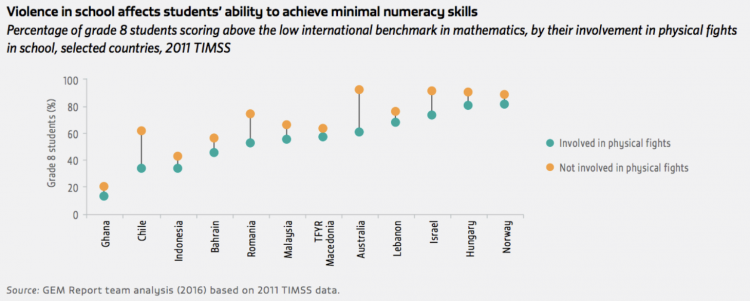
Abuse in early years tin can undermine lifelong learning
Physical and psychological corruption are often linked to negative effects on mental and concrete wellness. For case, it has been documented that anxiety and depression tend to arise more ofttimes amidst children who are abused.17
Again, these correlations practise not imply causation. Merely in that location are good reasons to accept them seriously. The World Development Report (2018) notes that toxic stress in the early years tin can undermine lifelong health, learning, and behavior, considering the hormones associated with the fight-or-flying response, such every bit cortisol, can inhibit physical growth and the children's susceptibility to disease. It is also the case that these hormones tin impair the development of neural connections in parts of the brain that are critical for learning.
The following is an case of the type of brain development problems that scientists aspect to sensory neglect in early childhood. The source is Perry (2002).eighteen The CT scan on the left is an image from a healthy three year old with a typical head size (at the 50th percentile of the distribution). The epitome on the right is from a 3 year old child suffering from 'severe sensory-deprivation fail' – minimal exposure to linguistic communication, touch, and social interactions. The brain of the kid on the right is significantly smaller than average (3rd percentile) and has signs of deterioration (cortical atrophy).
Of form, this comparison is just an illustration, and it is hard to know with certainty whether the observed differences in encephalon size tin can exist fully attributed to sensory-deprivation fail. However, Perry finds that the boilerplate head size amid a grouping of 40 children who had suffered sensory neglect is below the fifth percentile in the distribution – and while some recovery in brain-size was observed after children were removed from the neglectful environment, in most cases the gaps remained pregnant.
These findings are relevant to education because brain malleability is much greater earlier in life, and brain evolution is sequential and cumulative; which means that brain deterioration can atomic number 82 to permanent impairments on skill acquisition.19
Brain browse from a non-neglected child with an average head size (left) in comparison to a browse from a child suffering from severe sensory-deprivation neglect (right) – Perry (2002)twenty
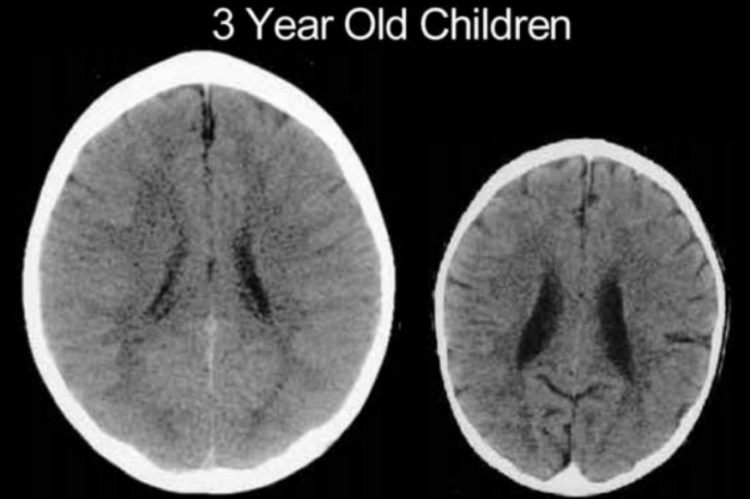
The interaction between violence and pedagogy operates in both directions
The interaction between violence and education operates in both directions, which means education can exist used every bit an musical instrument to reduce the prevalence of violence. In Uganda, for case, a programme that provided life skills and vocational training for girls who had been forced into sexual acts, led to essentially fewer of these girls beingness victims of sexual abuse – an bear upon largely attributed to caused skills (Bandiera et al. 2017).21
Similarly, parenting interventions that promote skills and cognition amongst parents have shown positive effects on domestic violence. In Republic of liberia, for example, a programme that provided training in positive parenting and non-tearing behaviour reduced violent penalty drastically (Sim et al. 2014).22
Data Quality and Measurement
Most of the available cantankerous-country data on violence against children comes from self-reported incidents and behavior in household surveys. This entails two important limitations. Start, there is a tendency for self-reported violence to exist biased. This is to be expected, since violence confronting children is often illegal, and even when information technology is not, it typically involves some of the most private aspects of everyday family life. Secondly, there are often comparability problems, since the survey instruments oft change across time and countries.
Despite these limitations, the available data is however helpful to shed light on the rough order of magnitude of the problem. Much work needs to be done to improve data quality and availability on this topic. Just what is currently available is already a good place to kickoff.
Information Sources
UNICEF Information: Monitoring the Situation of Children and Women
- Information Source: UNICEF; Information and Analytics Department; Partitioning of Information, Research and Policy
- Description of available measures: UNICEF uses the term 'child protection' to refer to prevention and response to violence, exploitation and corruption of children in all contexts. This includes reaching children who are especially vulnerable to these threats, such equally those living without family care, on the streets or in situations of conflict or natural disasters.
- Geographical coverage: Global by country (predominantly depression and middle income countries)
- Link: https://data.unicef.org/topic/child-protection/overview/
Source: https://ourworldindata.org/violence-against-rights-for-children
0 Response to "Family Violence Is Most Difficult to Detect Due to"
Post a Comment